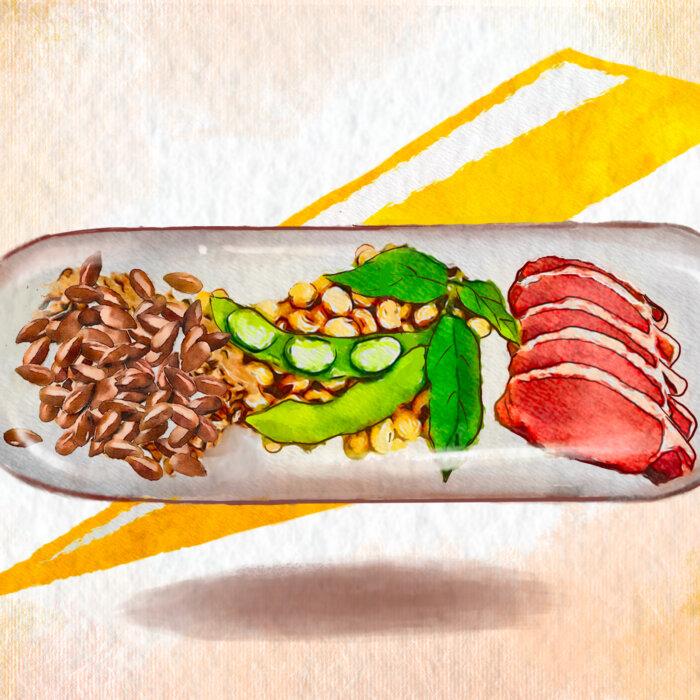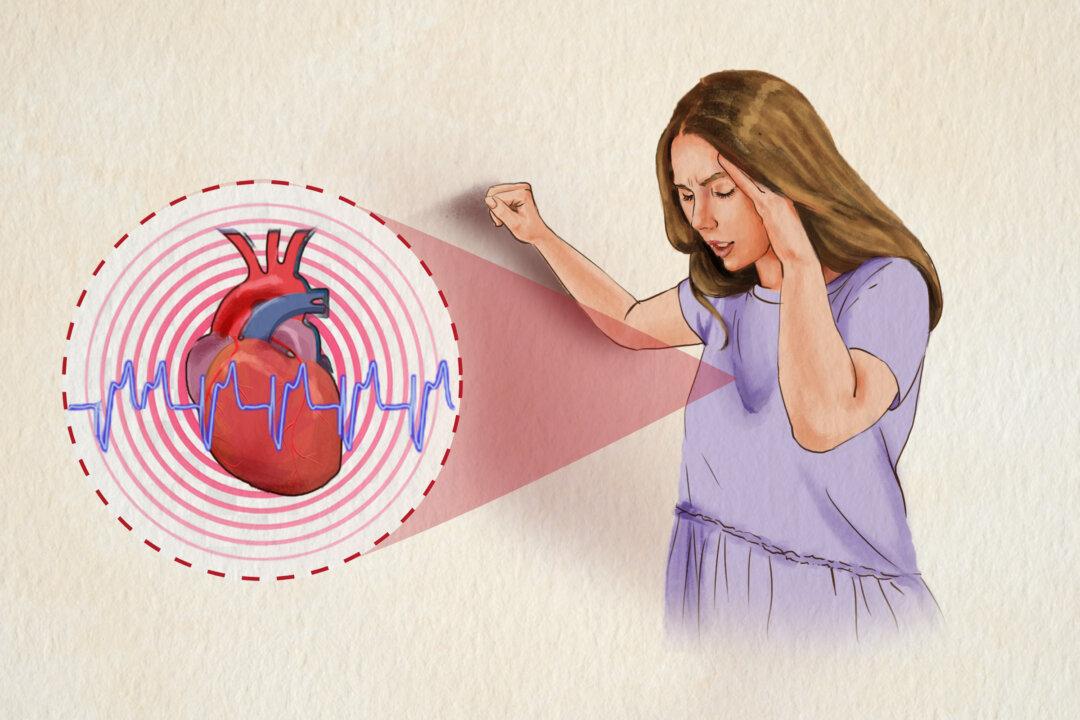Nineteen children with migraine were asked to take riboflavin daily. After three months, about 90 percent experienced significant improvement, and of those, 37 percent recovered completely, according to a 2021 study.
The importance of riboflavin, or vitamin B2, is often overlooked. Despite its role in various bodily functions, ranging from treating migraines to protecting against anemia, riboflavin frequently flies under the radar, earning it the nickname the “forgotten” vitamin, according to a 2020 article in the International Journal of Molecular Sciences.
What Is Riboflavin’s Job?
Riboflavin is essential for generating energy in the body by helping to break down carbohydrates, fats, and proteins.
It also acts as a powerful antioxidant, protecting cells from oxidative stress and free radical damage. It is a key component of the glutathione redox cycle, which helps maintain the body’s antioxidant defenses by regenerating glutathione.
Consequently, riboflavin may play a role in the prevention or treatment of chronic diseases that involve oxidative stress. For instance, riboflavin reportedly has a positive effect on blood sugar, and it can reduce hyperglycemia (abnormally high level of blood sugar) while decreasing tissue damage and cellular DNA damage in mice.
What Are the Different Types of Riboflavin?
When we talk about riboflavin, we’re not just discussing a single compound. This versatile vitamin comes in several forms, each playing a unique role in our bodies’ complex biochemical orchestra.
The main players in the riboflavin family include:
- Free riboflavin: This is the basic unmodified, free form. It is found in foods like milk and eggs.
- Flavin mononucleotide (FMN): This phosphorylated form activates other vitamins, such as vitamin B6.
- Flavin adenine dinucleotide (FAD): FAD is the most common form in body tissues and is vital for energy production.
What Are the Key Health Benefits of Riboflavin?
Riboflavin contributes to numerous vital functions in the human body and offers a wide range of health benefits.
1. Fights Migraine
Riboflavin helps reduce oxidative stress and nerve inflammation, which are linked to migraine headaches. It also plays a crucial role in normal mitochondrial function, and since mitochondrial abnormalities can contribute to migraines, riboflavin is studied as a preventive therapy for migraine. High-dose riboflavin supplementation has shown promise in reducing the frequency and severity of migraine headaches in some individuals.
Despite being known by some as the “forgotten” vitamin, riboflavin is versatile and integral for healthy eyes, brain, nerves, and blood cells. Illustration by The Epoch Times, Shutterstock
2. Maintains Healthy Vision
Riboflavin is crucial for eye health. It may help prevent cataracts and maintain normal vision. In a new treatment for corneal ectasia called corneal cross-linking, riboflavin eye drops are used with ultraviolet-A light to strengthen the cornea. Researchers are exploring riboflavin’s potential in treating other eye disorders, including glaucoma and keratoconus.3. Prevents Anemia
Riboflavin plays a role in iron absorption and utilization, and its deficiency may lead to anemia and iron metabolism. The vitamin also helps form red blood cells and with the transport of oxygen to cells.4. Protects the Brain and Nerves
Emerging research suggests that riboflavin may have neuroprotective effects, thus potentially benefiting individuals with certain neurological disorders. For example, multiple sclerosis (MS) is an autoimmune disease where the body’s immune system attacks the myelin and nerve fibers in the central nervous system, leading to progressive damage. As riboflavin is crucial for the formation of myelin, its deficiency is considered a risk factor for MS. According to a 2018 review, riboflavin may have neuroprotective effects in MS by supporting pathways often impaired in such conditions, including antioxidation, myelin formation, mitochondrial function, and iron metabolism.5. Reduces Cancer Risk
Although debated, riboflavin may be associated with a reduced risk of some cancers, according to the International Journal of Molecular Sciences article. For instance, riboflavin regenerates glutathione, an anti-cancer agent and a powerful antioxidant involved with cell differentiation, proliferation, cell death, and immune function.A 15-year prospective study of 41,514 individuals in the Melbourne Collaborative Cohort Study found that current smokers with higher dietary riboflavin intake (2.5 milligrams per day on average) had a significantly lower risk of lung cancer, while this inverse association was not observed in former or never smokers.
6. Supports Immunity
Riboflavin is essential for the proper functioning of the immune system. It enhances the activity of neutrophils and macrophages, key players in the body’s defense against pathogens.7. Helps With Fetal Development
Adequate riboflavin intake during pregnancy is crucial for proper fetal development, particularly to help prevent certain birth defects such as congenital heart issues.8. Supports Mitochondria and Energy Production
Riboflavin is vital for mitochondrial energy production. Since some people with autism have mitochondrial dysfunction, adequate riboflavin levels may improve cellular energy metabolism in these individuals. A 2011 study suggested that supplementing with vitamin B2, vitamin B6, and magnesium can reduce abnormal organic acids, specifically dicarboxylic acids, in the urine of autistic children.9. Maintains Skin and Hair Health
Riboflavin contributes to maintaining healthy skin, mucous membranes, and hair.10. Lowers Blood Pressure
According to a 2010 article, riboflavin supplementation lowered blood pressure in patients with cardiovascular disease and the MTHFR TT genotype. FAD serves as a cofactor for the MTHFR enzyme.Riboflavin may also be capable of managing metabolic disorders and cardiovascular health.
How Common Is Riboflavin Deficiency?
Riboflavin deficiency is “endemic” in many parts of the world, including within certain populations among affluent societies. While severe riboflavin deficiency is rare in developed countries, subclinical deficiency may be more common than previously thought. Certain conditions and factors increase the risk of riboflavin deficiency, including:
- Age: Older people experience decreased absorption and dietary intake of riboflavin.
- Alcoholism: Alcohol interferes with riboflavin absorption and utilization. It is also a diuretic, which increases the loss of riboflavin as fluid loss increases.
- Chronic diseases affecting nutrient absorption: These include recurrent diarrhea, liver disorders, chronic alcohol use disorder, and malabsorption disorders that impair food absorption.
- Pregnancy and lactation: Pregnant and lactating women have increased riboflavin requirements and may be at higher risk of deficiency, especially in developing countries.
- Veganism and strict vegetarianism: Vegetarians do not consume dairy or meat products and thus could be at an increased risk of riboflavin deficiency.
- Oral contraceptives: Oral contraceptives may interfere with riboflavin metabolism.
- Increased energy needs: Athletes require more riboflavin.
- Genes affecting riboflavin transport or metabolism: Individuals with mutations in riboflavin transporter genes (e.g., SLC52A2 and SLC52A3) may have impaired riboflavin absorption and utilization, leading to deficiency even with adequate dietary intake.
- Certain procedures: For example, hemodialysis and peritoneal dialysis, which filter the blood, can contribute to riboflavin deficiency.
What Are the Signs and Symptoms of Riboflavin Deficiency?
Riboflavin deficiency, also known as ariboflavinosis, can manifest in various ways. Depending on the extent of the deficiency, the signs and symptoms can range from mild to severe.
Many of these symptoms and signs are nonspecific and can be associated with other nutritional deficiencies or health conditions, including malignancies and peripheral neuropathy. Additionally, riboflavin deficiency often occurs alongside deficiencies of other B vitamins, which can complicate the clinical picture.
Common manifestations include:
- Oral and throat symptoms (sore throat, chapped lips, sores at corners of the mouth, magenta-colored and swollen tongue)
- Skin issues (rashes, acne, wrinkles, slow wound healing, scaly skin)
- Eye problems (light sensitivity, itchy or watery eyes, pink eye, impaired vision, night blindness, cataracts)
- Neurological symptoms (seizures, decreased or absent reflexes, nervous system degeneration)
- Normochromic normocytic anemia due to impaired iron absorption and utilization
- General symptoms (fatigue due to iron malabsorption, stunted growth in children, migraine, depression)
- Reproductive issues (fetal development issues, birth defects, preeclampsia in pregnant women)
- Impaired metabolism of other B vitamins, as well as altered fat and carbohydrate metabolism
- Digestive issues (inability to digest carbohydrates, fats, and proteins; slowed digestion; diarrhea)
- Hair loss
Does My Body Make Riboflavin?
Certain microbes in our gastrointestinal tracts can make riboflavin. Scientists have known this since at least 1997, according to research published in the European Journal of Cancer Prevention. More recent research confirms this.
However, our modern lifestyles are characterized by energy-dense but nutrient-poor processed food, overuse of antibiotics, and chronic stress—all of which can reduce gastrointestinal microbiota diversity, according to a 2021 article in Best Practice & Research Clinical Endocrinology & Metabolism.
The reduction in microbial diversity may reduce the ability to produce adequate amounts of riboflavin in our gastrointestinal tracts, which could contribute to a greater reliance on foods as a source of riboflavin.
What Are the Dietary Sources of Riboflavin?
Riboflavin is found in a variety of foods, such as the following. Riboflavin content is milligrams (mg) per 100 grams.
Organ Meats
- Raw lamb liver (3.63 mg)
- Cooked beef liver (3.42 mg)
- Cooked beef kidneys (2.97 mg)
- Whole eggs (1.98 mg) (both egg whites and yolks are high in riboflavin)
- Almonds (1.14 mg)
- Sunflower seeds (0.355 mg)
- Hulled hemp seeds (0.285 mg)
- King mackerel (0.58 mg)
- Anchovies (0.363 mg)
- Tuna (0.306 mg)
- Crude wheat germ (0.499 mg)
- Raw oat bran (0.22 mg)
- Kale (0.347 mg)
- Spinach (0.189 mg)
- Asparagus (0.141 mg)
- Whole-milk plain yogurt (0.243 mg)
- Low-fat cheese (0.234 mg)
- Low-fat milk (0.14 mg)
- Kidney beans (0.219 mg)
- Lentils (0.211 mg)
- Green peas (0.132 mg)
- Yeast extract spread (17.5 mg)
- White mushrooms (0.402 mg)
- Cooked quinoa (0.11 mg)
- Fortified breakfast cereals (check individual labels for riboflavin content)
- Fortified bread products
- Fortified pasta
In many countries, particularly in the developed world, many food products such as flour and breakfast cereals are fortified with riboflavin, which has significantly reduced the prevalence of deficiency.
Recipe: Riboflavin-Rich Meatballs
Makes 24–28 meatballsChoose organic ingredients when possible.
Ingredients:
- 1 pound ground beef
- 0.25 pound (about 4 ounces) beef liver, finely minced or ground
- 2 large eggs
- ½ cup almond flour
- ½ cup freshly grated Parmesan cheese
- 2 cloves garlic, minced
- 2 teaspoons dried oregano
- Salt and pepper to taste
- 2 tablespoons cooking fat (choose: olive oil, avocado oil, butter or ghee from 100 percent grass-fed cows, or coconut oil)
There are two options for mixing the ingredients:
- Traditional method: In a large bowl, combine the ground beef, minced beef liver, eggs, almond flour, Parmesan cheese, garlic, oregano, salt, and pepper. Mix well by hand.
- Food processor method: Place all ingredients in a food processor and pulse until well combined. This will create a smoother, softer texture for the meatballs.
- Form the mixture into small meatballs about 1 inch in diameter.
- Heat your chosen cooking fat in a large skillet over medium heat. Cook the meatballs in batches, turning occasionally, until browned on all sides and cooked through (about 8 to 10 minutes per batch).
- Remove meatballs from the skillet and serve as desired.
Serving suggestions:
These versatile meatballs can be enjoyed in various ways:
- Serve with marinara sauce over spaghetti squash for a low-carb option
- Add to your favorite pasta dish with tomato- or cream-based sauce
- Serve as an appetizer with a side of Greek yogurt-based dip
- Include in a meatball sub sandwich with melted cheese
- Add to a vegetable soup for extra protein and flavor
- Serve over a bed of sautéed vegetables like zucchini noodles or riced cauliflower
- Use as a protein addition to salads
- Pair with a side of roasted vegetables for a simple, nutritious meal
- Serve with a side of tzatziki sauce and Greek salad for a Mediterranean-inspired meal
- Add to a stir-fry with mixed vegetables and serve over brown rice
How Can I Optimize Riboflavin Intake and Absorption?
Here are some strategies to enhance riboflavin intake and absorption:
- Eat a diverse diet: Eating a varied diet with multiple sources of riboflavin ensures you get enough of this vitamin while also providing other essential nutrients that work synergistically with riboflavin.
- Store properly: Riboflavin-rich foods, especially milk and dairy products, are sensitive to light and should be stored away from light to prevent degradation of the vitamin.
- Choose the right cooking method: Riboflavin, being water-soluble, is lost more in cooking water when foods are boiled compared to methods such as steaming or baking.
- Combine with other foods: Riboflavin’s absorption rate is proportional to its intake and increases when consumed with other foods. While most forms of riboflavin are water-soluble, consuming them with a small amount of healthy fat can enhance the absorption of fat-soluble vitamins that often work in concert with riboflavin.
- Avoid alcohol: Drinking alcohol can impair riboflavin absorption.
- Supplement wisely: If using supplements, take them with meals to enhance absorption.
- Address underlying conditions: Certain health conditions, such as lactose intolerance, celiac disease, malignancy, and malabsorption disorders, can impair nutrient absorption. Managing these conditions can help improve riboflavin levels.
- Consider genetic factors: People with genetic variations affecting riboflavin transport or metabolism may require higher intakes or specific forms of the vitamin.
- Maintain a healthy gut: A healthy gut microbiome can contribute to riboflavin production and absorption. Consuming prebiotics and probiotics may be beneficial.
- Consume small amounts: Consuming smaller portions of riboflavin-containing food frequently may also improve overall absorption, as the body usually absorbs 27 milligrams of riboflavin in a single instance.
Which Nutrients Boost Riboflavin’s Effects?
Understanding the synergistic relationships between riboflavin and other nutrients can help optimize overall nutritional status. When considering supplementation, particularly for therapeutic purposes, awareness of these interactions is vital for designing effective strategies.
The following vitamins and minerals are complementary to riboflavin:
- Vitamin B1 (thiamine): Thiamine works with riboflavin in energy metabolism.
- Vitamin B3 (niacin): Riboflavin is essential for converting tryptophan to niacin.
- Vitamin B6 (pyridoxine): Riboflavin plays a role in vitamin B6 metabolism.
- Vitamins B9 (folate) and B12 (cobalamin): Both folate and cobalamin collaborate with riboflavin in various metabolic processes.
- Iron: Riboflavin enhances iron absorption, utilization, and mobilization from tissues. Combining iron with riboflavin can be particularly effective in treating certain types of anemia.
- Zinc: Zinc and riboflavin work together in antioxidant processes. Zinc serves as a cofactor for key enzymes essential for the proper functioning of the body’s antioxidant defense system, while riboflavin’s strong antioxidant properties help fight oxidative stress and reperfusion oxidative injury (injury occurring as blood returns after a period of low oxygen). In addition, riboflavin kinase, the enzyme that plays a crucial role in the metabolism of riboflavin, is zinc-dependent.
- Magnesium: FAD synthase, an enzyme requiring magnesium, converts FMN to FAD. Combining magnesium with riboflavin has shown promise in migraine prevention.
- Coenzyme Q10: Coenzyme Q10 (CoQ10) and riboflavin collaborate in the electron transport chain for energy production. Specifically, CoQ10 is a key part of the mitochondrial electron transport chain, situated in the inner mitochondrial membrane. Research indicates that combining CoQ10 with riboflavin may amplify their individual benefits, especially in addressing mitochondrial disorders.
What Types of Riboflavin Supplements Are Available?
There are several types of riboflavin supplements, including:
- Tablets or capsules: These are the most common form of riboflavin supplements and are taken orally with water. Tablets of 25 milligrams, 50 milligrams, and 100 milligrams are available.
- Softgels: Softgels are another oral form of riboflavin supplements. They may contain riboflavin along with other nutrients or oils for better absorption.
- Liquid supplements
- Multivitamin or multimineral supplements: Riboflavin is frequently included in multivitamin and multimineral supplements, alongside other B vitamins and essential nutrients.
What Are Other Ways to Get Riboflavin?
While dietary sources and oral supplements are the most common ways to obtain riboflavin, other methods are available, including:
- Probiotics: Certain probiotic strains can produce riboflavin in the gut, but their output is insufficient to meet dietary needs.
- Intravenous (IV) administration: In severe deficiency or malabsorption cases, riboflavin can be administered intravenously, bypassing the digestive system for direct delivery into the bloodstream.
- Intramuscular injections: Sometimes used in clinical settings to rapidly correct deficiency, intramuscular injections may be preferred when oral administration is not feasible or effective.
- Topical applications: Riboflavin is used in some skin care products for its potential antioxidant benefits.
- Transdermal patches: Transdermal patches are medicated adhesive patches that deliver a specific dose of medication through the skin into the bloodstream over time, providing controlled release. While not commonly used, transdermal patches for riboflavin are available.
- Nasal sprays: Some studies have explored nasal delivery of riboflavin, particularly for migraine prevention.
- Fortified personal care products: Some shampoos and hair care products are fortified with riboflavin, although their efficacy requires further investigation.
What Is the Recommended Dietary Allowance of Riboflavin?
The following are the current Recommended Dietary Allowances (RDAs) for riboflavin as specified by the Food and Nutrition Board of the Institute of Medicine. Adequate intake (AI) amounts are recommended for infants under 12 months.

The RDAs for riboflavin. Illustration by The Epoch Times
Individual needs may vary. Factors that can increase riboflavin requirements include:
- Physical activity: Athletes and those engaging in regular intense exercise may need more riboflavin.
- Stress: Periods of high stress can increase the body’s demand for B vitamins.
- Illness: Certain health conditions can increase riboflavin needs or impair its absorption.
- Smoking: Smokers may have higher riboflavin requirements.
- Certain medications: Some drugs can interfere with riboflavin absorption or increase its excretion.
How Can I Test My Riboflavin Levels?
There are several methods to assess riboflavin status in the body, including the following:
- Erythrocyte glutathione reductase activity coefficient (EGRAC): EGRAC is considered the gold standard for assessing riboflavin status. It measures the activity of glutathione reductase, an enzyme dependent on FAD. An EGRAC value of 1.2 or less indicates adequate riboflavin status; 1.2 to 1.4 suggests marginal deficiency; and greater than 1.4 indicates riboflavin deficiency. This test is sensitive but requires specialized laboratory equipment.
- Urinary riboflavin excretion: This method measures the amount of riboflavin excreted in urine over 24 hours. Levels below 40 milligrams a day suggest deficiency. This method can reflect recent intake but may not accurately represent long-term status.
- Plasma or serum riboflavin levels: This is the direct measurement of riboflavin in blood. It is less commonly used due to the rapid fluctuations in blood levels after meals, but it can be useful in conjunction with other tests. There is no official reference range.
- Riboflavin loading test: A riboflavin loading test involves giving a dose of riboflavin and measuring urinary excretion. It can help differentiate between dietary deficiency and absorption issues.
- Measurement of FAD in red blood cells: This provides information on long-term riboflavin status and is less affected by recent dietary intake compared to plasma levels.
- Fluorometric assay: Fluorometric assay uses riboflavin’s natural fluorescence to measure levels in various biological samples.
- High-performance liquid chromatography (HPLC): HPLC is a precise method for measuring riboflavin and its coenzyme forms in biological samples.
- Clinical assessment: Clinical signs and symptoms can be used alongside lab tests to assess riboflavin status, providing valuable clues despite not being a direct measurement.
- Genetic testing: When riboflavin transporter deficiency is suspected, genetic tests can identify mutations in relevant genes.
What Happens if I Get Too Much Riboflavin?
Riboflavin is generally considered to have low toxicity due to its water-solubility and limited absorption capacity. Therefore, the Food and Nutrition Board doesn’t have a tolerable upper intake level for riboflavin. However, very high doses can lead to potential adverse effects, although rare. Symptoms and signs of excess riboflavin include the following:
- Bright yellow urine: This is the most common and harmless sign of high riboflavin intake. The gastrointestinal tract absorbs the riboflavin, which then travels through the blood and is filtered by the kidneys into the urine. As riboflavin is a water-soluble vitamin, any excess is excreted through the kidneys, resulting in bright yellow urine.
- Gastrointestinal distress: Very high doses may cause diarrhea, nausea, abdominal pain, or other types of gastrointestinal distress in some individuals. This is more likely with large, single doses rather than cumulative intake over time.
- Increased sensitivity to light: Some individuals may experience increased photosensitivity.
- DNA strand breaks: Excess riboflavin may raise the risk of DNA strand breaks when chromium, a carcinogen, is present.
- Skin reactions: In rare cases, very high doses might cause itching or numbness.
- Numbness or tingling
Which Medications and Nutrients Interact With Riboflavin?
While riboflavin is generally safe and has few interactions, some medications may interact with this vitamin. These interactions can either affect riboflavin levels in the body or alter the effectiveness of the medication. Here are some key interactions to be aware of:
- Anticholinergic drugs: These medications, used to treat various conditions, including depression and gastrointestinal spasms, may reduce riboflavin absorption. Examples include oxybutynin and ipratropium.
- Antidepressants: Certain antidepressants, particularly tricyclic antidepressants, may reduce riboflavin levels. Examples include amitriptyline and imipramine.
- Antipsychotic medications: Some antipsychotics, especially phenothiazines, lower riboflavin levels in the body. Examples include chlorpromazine and thioridazine.
- Barbiturates: Barbiturates, such as primidone and phenobarbital, are occasionally prescribed for conditions like seizures. They are classified as depressant drugs, which reduce brain and body activity, inducing feelings of calmness or sleepiness. Prolonged use of the anticonvulsant phenobarbital can enhance riboflavin breakdown by liver enzymes, potentially raising the risk of deficiency.
- Probenecid: Probenecid, used to treat gout, may decrease the digestive tract’s absorption of riboflavin while increasing riboflavin excretion, thus potentially leading to lower levels.
- Methotrexate: This drug, used for cancer treatment and autoimmune diseases, may interfere with the body’s use of riboflavin. Thus, riboflavin supplementation might be necessary for some patients on long-term methotrexate therapy.
- Oral contraceptives: Research suggests that oral contraceptives may lower riboflavin levels.
- Doxorubicin: This chemotherapy drug may interact with riboflavin metabolism, potentially depleting riboflavin.
- Penicillin derivatives: Penicillin derivatives may lower riboflavin levels in some individuals.
- Tetracycline: Riboflavin may interfere with the absorption of the antibiotic tetracycline. It’s recommended to separate the intake of riboflavin and tetracycline by several hours.
- Quinolone antibiotics: Similar to tetracyclines, riboflavin may interfere with the absorption of quinolone antibiotics such as ciprofloxacin, gatifloxacin, and ofloxacin. Quinolones may also deplete riboflavin from the body.
- Thiamine: High doses of thiamine may compete with riboflavin for absorption.
- Photosensitizing drugs: Riboflavin can increase light sensitivity. This could potentially enhance the effects of drugs that cause photosensitivity, such as certain antibiotics or acne medications.
- Propantheline: This anticholinergic drug may delay riboflavin absorption but later cause more amounts to be absorbed.
- Phenytoin: Phenytoin, prescribed for managing seizures, can influence riboflavin levels within the body.
- Diuretics (water pills): Thiazide diuretics such as hydrochlorothiazide can increase the loss of riboflavin through urine.







